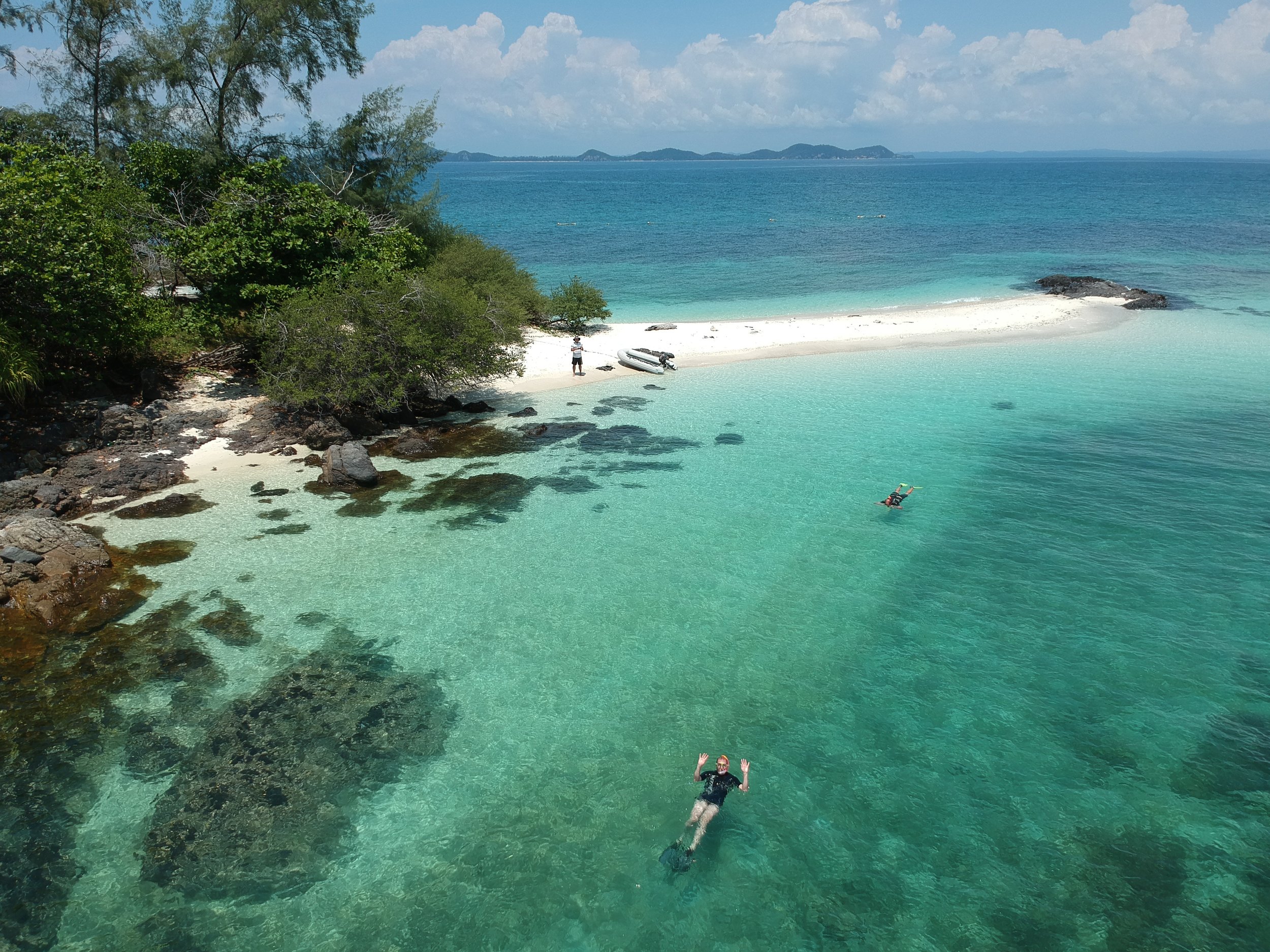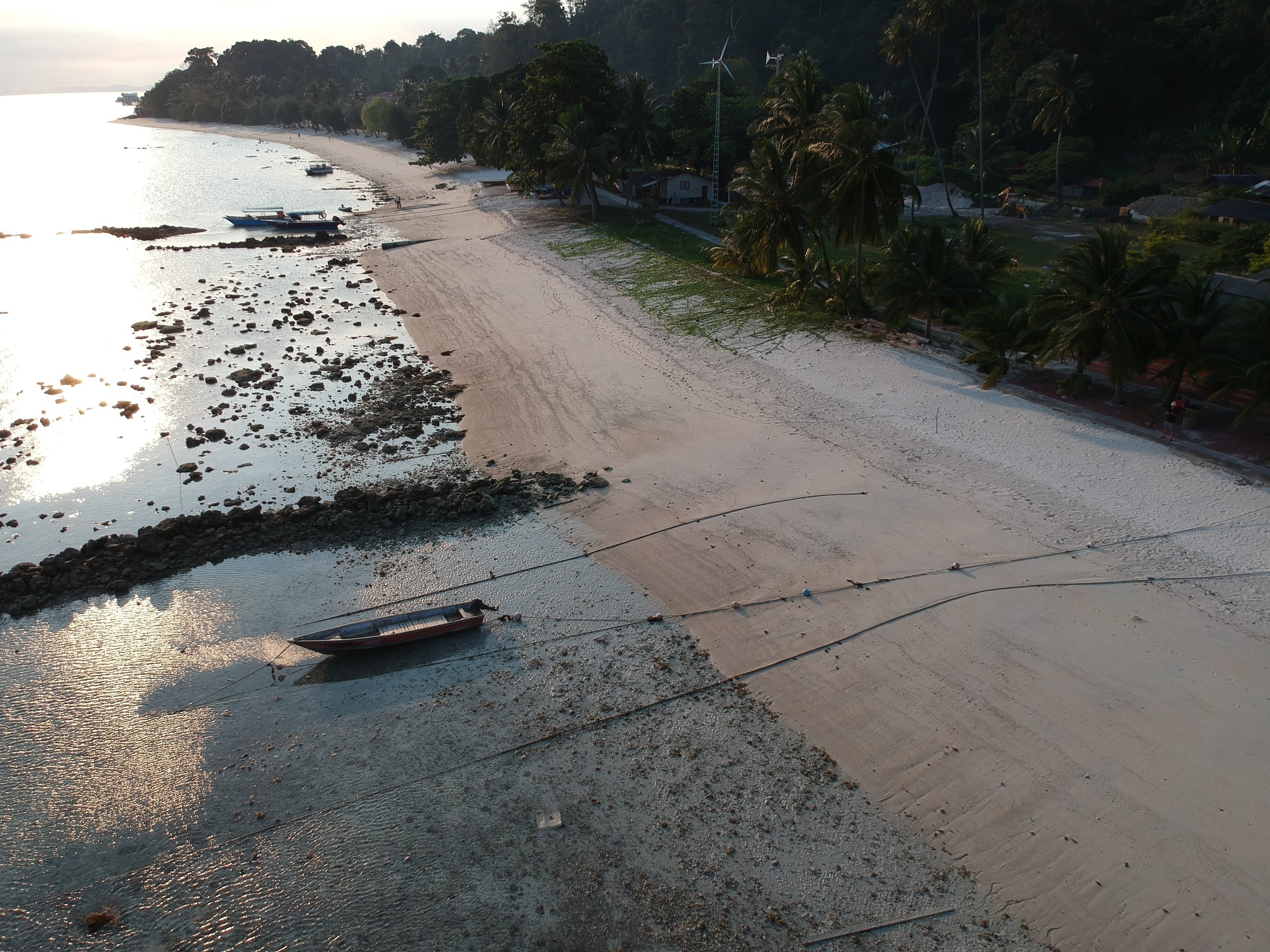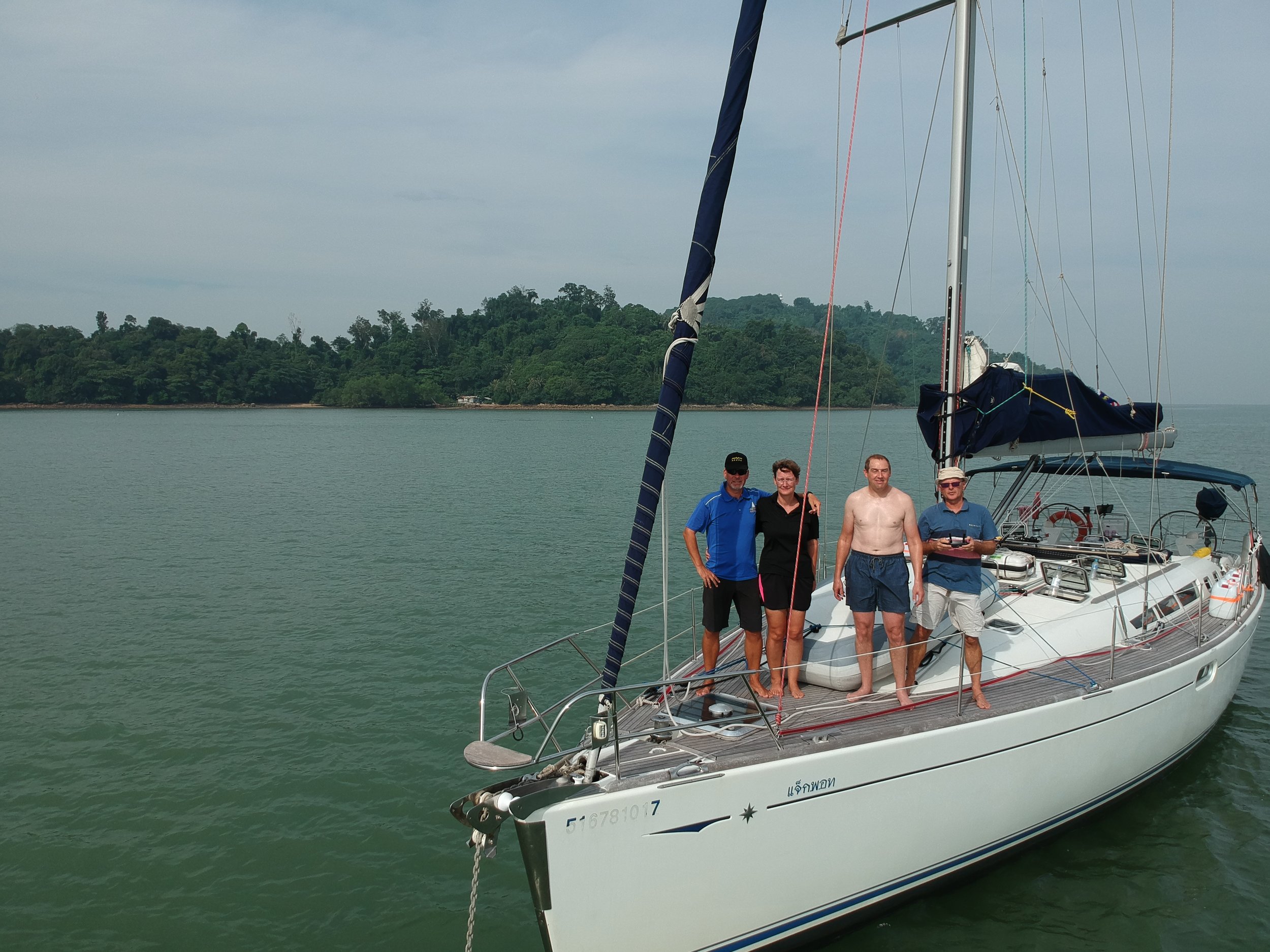Not Seasickness – Landsickness!
With three German friends I boarded a 49-foot sailing yacht on the Island of Tioman in the South China Sea. Our destination: the city of Port Dickson, on the west coast of Malaysia, my first multi-day cruising experience. After bunkering diesel and plenty of drinking water as well as food for at least 10 days, we set off in southern direction the next morning.
As there was too little wind for sailing we motored to Pulau Sri Buat for our first overnight stay and continued the next day to Pulau Tinggi. The waters were calm and we saw some flying fish on the surface and dolphins at the stern of the boat. Pulau Tinggi (translated this means ‘Tall Island’) has a cone shape mountain, the remains of an old volcano. The island is lush green of tropical jungle and coconut palms, seamed with mangrove and some coral reefs. On the island there is only one restaurant catering for 20 guests.
We hadn’t seen any other pleasure boats since two days. Four wooden fishing trawlers anchored next to us, years of salty air had removed the last bit of paint on them. With our rubber dingy we went to Pulau Mentigi, a 70-metre-long and 20 meters wide island with coral reefs and white sand. An ideal spot to make some exotic pictures. On our way back to the boat we saw a 1-meter long turtle gently swimming towards the island.
The next day we anchored at Pulau Sibu in the middle of a marine park. Again a volcanic island with white sandy beaches, covered with dense jungle. There were around 50 tourists from Singapore on the Rimba resort, clean, peaceful and serving good food and drinks.
After a good night sleep, we had a humid 9-hour passage ahead of us with the scorching sun straight above. The seas again were calm, and I saw schools of fish being pushed to the surface by predators. There was an oil platform on horizon, a few trawlers as the sun rose from the east. A tugboat towed a barge heading for Singapore. We sailed parallel to the hilly coastline.
As we approached Singapore, big ships started to appear on the horizon. Heading further south we encountered more and more ships. Some on anchor waiting to enter Singapore harbour, others heading through the main shipping channel to port. We passed a barge which had dropped its anchor 5 miles off-shore, offloading bauxite onto a Chinese bulk carrier.
Before we anchored at Tangjung Pengelih, we bunkered diesel fuel from a supply barge. In the evening we watched streaks of lightning on horizon as planes landed and took off from Changi International Airport.
The next morning we prepared the boat to start our turn around Singapore. However, within one hour the weather turned ugly: wind gusts 25 knots and rain as an out-layer of a thunderstorm over the Singapore Strait. We broke of our departure and spent that day on the boat for anchor. It was a relaxing day. At lunchtime we took our dinghy and motored to the ferry terminal of Tangjung Pengelih to have a meal at the local eatery. I washed some clothes and sat crossed legged on the deck, watching the fishermen inspect their nets and enjoying the fresh salty air.
The following day we finally got on our way just after sunrise. But one hour after we started our 10-hour turn around Singapore, a westerly storm picked-up with 30 knots winds, heavy rain, 2.5-meter gray, white capped waves. Visibility hundred meters. The boat pitched and rolled in the choppy waters. Saltwater sprayed onto the deck. Elliott and Astrid remained below deck while Peter, our captain, and myself stayed in the cockpit, tethered to the boat for 2 hours all on one of the busiest shipping lanes in the world! We saw containerships, chemical bulk carriers, car carriers, oil tankers, oilrigs, ferries, tugboats, pilot boats, cruise ships and liquified gas tankers going in and out the Singapore ports.
Navigating between all that traffic required all our attention and energy. Then a Coast Guard patrol boat came along side.
“Move into the main shipping lane at once, or we call you into port,” the young officer yelled at us. “you are in Singaporean territorial waters.”
Not the thing we wanted to do considering the heavy shipping traffic, but we had no choice in the matter. For the next hour we sailed on the edge of the main shipping lane with several 3-4-hundred meters long vessels passing us. When the rain stopped I could see the skyline of Singapore in thick black rain clouds. Only once we passed Sentosa Island, we had more room to manoeuvre our boat. Now refineries, gas terminals and container ports lined the horizon as far as we could see. A navy ship patrolled inside the shipping lane in opposite direction and during one hour we sailed side by side with a USA navy tanker ship in north-westerly direction. After a long and busy day, we dropped anchor at Pulau Pisang in Malaysia, an unhabituated island with one white lighthouse. In the evening I watched the lights of the big ships ploughing the Strait of Malacca, connecting China with Europe as the beam of the lighthouse swept over the water.
Life on board meant a different routine. No matter how small the island we had anchored on was, there always seemed to be a mosque and most mornings I woke up to the calls to prayer by the muezzin. We lifted anchor just after sunrise, enough time to jump in the sea to wash and take an al fresco shower on the transom of the boat. (I did swim in the sea until halfway our journey I saw a 1-meter brown coloured jellyfish pulsating, gently floating by, just under the surface: no swimming anymore since!). We always tried to go on shore in the evening to stretch our legs and maybe to eat something, but that was not always possible. In the evening we invited fellow sailors who anchored close by for sun-downers on our boat. Talk was about anchor places, safe passages, weather, tides and breakdowns of engines, generators and navigation. An altogether different lifestyle was revealed to me, with people living up to 15 years on their yacht, cruising the world. After dark we saw lights of fishing boats catching squid and lightning of thunderstorm on the horizon. Away from bright city lights, clear stars and the milky way overhead made for some relaxing stargazing.
When motoring, we all took 2-hour watches to steer the boat, checking the autopilot and depth, watching for other ships crossing our route and foremost looking out for those fishing nets which could entangle into our propeller or bamboo fish farms in which we did not want to crash. When we had favorable winds, there was additional work to be done; tacking, trimming the sails, reefing and checking the wind. There was plenty of time to gaze at the endless sea, the curve of the horizon (yes, the world is indeed round). The water is brownish along the shallow sandy mangrove coastlines, turning turquois green a few hundred meters off-shore and eventually blue a few miles from the closest landmass. I took pictures of tropical islands, did some reading or checked the news on the smart phone as soon as we had good internet connections when we sailed close enough to the land. It took me just two days to get used to the new daily rhythm on this cruising boat, like checking the weather forecast, planning the route and programming the auto pilot, cooking (Oops, I did the dishes…), making coffee (very important!), washing, dropping the anchor, putting the rubber dinghy in the water, closing hatches and tying up lines when in wet weather. Being with 4 adults on a 49-foot sailboat did not feel cramped as we all had our own cabin and most of the time the weather was such that we could stay below deck as well as in the cockpit area.
We continued our journey and tried to anchor in Batu Pahat, but the river-inlet, known for its saltwater crocodiles, turned out to be too shallow. Instead, we headed a few miles north along the flat and mangrove lined coastline for another anchoring spot, 400 meters offshore. We saw ships in the shipping lane on the horizon, bamboo fish farm structures in the middle of the sea built be local fishermen.
During our journey through the Strait of Malacca, we encountered more and more fishing nets. At one point we had to detour at least 10 times to avoid nets with float lines attached to white floats and black flags at each end, stretching over 1 km. We saw seagulls sitting on floating coconuts and unfortunately increasingly we saw more debris floating on the water, like plastic bottles, bags, cans and fishing lines.
Anchoring at Pulau Besar, of the coast of Malacca. This island is a pilgrimage site for Muslims, mainly of Indian descent. It has 14 tombs with the remains of the family of Sultan Al Ariffin Syeikh Ismail, born in Baghdad in 1464 AD and 18th generation descendants of the Prophet Mohammed. Flower petals covered the tombs and I saw a pilgrim sprinkling water on one of the graves. Poor people, Malay and Indian-Malay, sleeping underneath tarps, in make-shift tents and small huts. I saw an old man with long grey scruffy beard washing himself at a fresh water well only 100 meters from the beach. Dare I say it: It all felt a bit mystical.
On this journey we met Australian and New Zealand ‘dropouts’ living many years on their yachts, pilgrims, poor locals eking out a living from tourism and fishery on the tiny islands, rich westerners and Singaporeans relaxing in a fine resort, other sailors via VHF radio exchanging infos on anchor places and weather, lonely fishermen working their nets on the open seas.
The last day we were sailing in good winds to Port Dickson. North of Malacca again we had to manoeuvre around oil tankers in the anchoring area off shore from a refinery. One tanker moored on a yellow loading buoy, held in position by three tugboats. But all went well.
Finally we sailed into Port Dickson marina, after 400 nautical miles 10-day sailing trip. We had a drink in the bar and everything seemed to move. I felt slightly off balance......landsickness, but grateful to have enjoyed this unique experience.





















